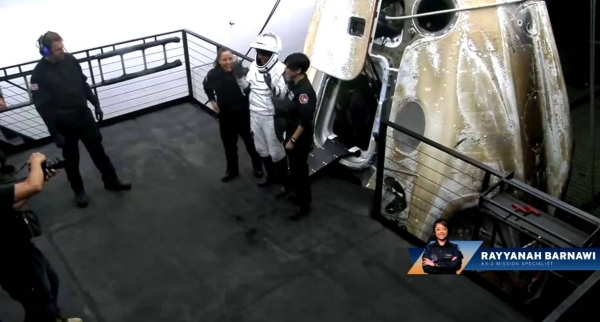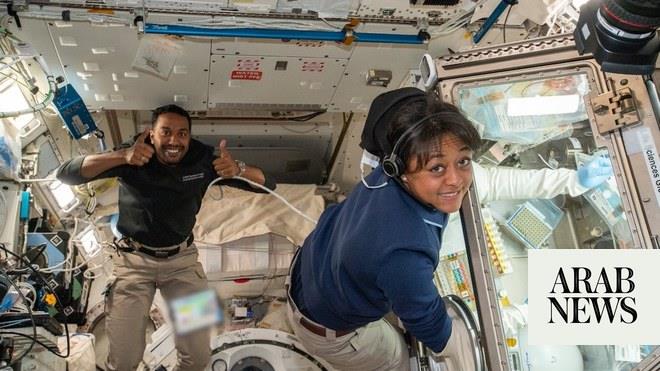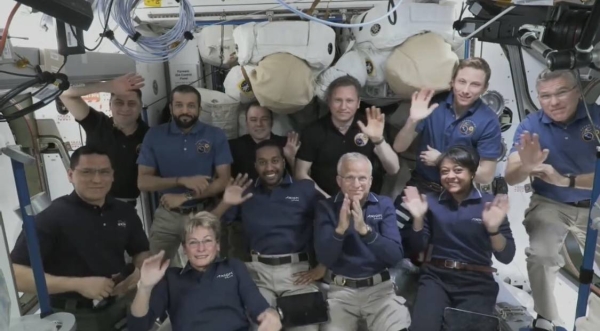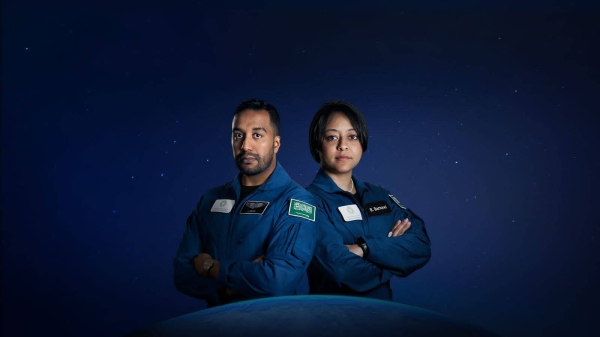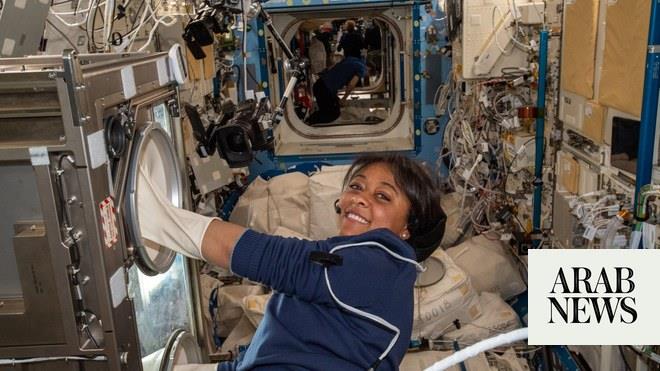
RIYADH: Saudi astronauts Rayyanah Barnawi and Ali Alqarni, and Americans Peggy Whitson and John Schoffner, made a safe splashdown off the coast of Florida early Wednesday morning, after completing a successful eight-day Ax-2 mission on the International Space Station.
The 12-hour journey of the Dragon capsule back to Earth from the ISS was watched live by many Saudi citizens, who expressed pride at the contribution of the two Saudi astronauts to space research.
After 10 days in orbit, Dragon and the Ax-2 crew have returned to Earth. (@SpaceX)
“I was more nervous watching their return to Earth as I learned it is often difficult for a returning spacecraft to reenter Earth’s atmosphere,” said 15-year-old Reema, a high school student based in Dhahran. “I stayed up all night to watch the live coverage of their arrival, and it was worth it, I felt proud to be Saudi.”
“I feel privileged to be living in a country aiming to empower its citizens with continued support from initiatives, workshops, scholarships, working day and night to mark Saudis’ footsteps in all fields,” said 34-year-old engineer Yasser, a chemical engineer based in Jubail Industrial City.
After 10 days in orbit, Dragon and the Ax-2 crew have returned to Earth. (@SpaceX)
Princess Reema bint Bandar Al-Saud, the Kingdom’s ambassador to the US, tweeted: “Filled with pride as I watch our astronauts and the Ax-2 team land safely back to Earth after their journey to ISS where they conducted scientific experiments that will further the frontier of scientific innovation and inspired a whole nation to dream and explore.”
Experiments in space
Barnawi and Alqarni successfully completed 14 science experiments in space. Three were part of the education outreach microgravity experiments, which involved over 12,000 students from 47 locations across the Kingdom.
The education outreach experiments, designed for students to think critically, were reportedly focused on demonstrating differences in fluid behavior on Earth and in microgravity, explore the aerodynamic behavior of different kite shapes on the ISS, and showcase the effects of the external environment of space on the available modes of heat transfer.
In the heat transfer experiment, the Saudi astronauts demonstrated how this took place in space by monitoring a wire as it heated and cooled, while students watched and compared how this differed from controlled experiments on Earth.
“The education outreach experiments aim to encourage their curiosity in space science as they are the future Saudi scientists, astronauts and engineers,” said Mishaal Alshemimry, a Saudi aerospace engineer and special adviser to the CEO of the Saudi Space Commission, in an interview with Al-Ekhbariya.
Among all the experiments conducted, 11 focused on the nervous system involving tissues, cells and molecules; four on immune cells; and one on cloud seeding in space, involving water-seeding technology. Several of the experiments were designed by Saudi scientists who had their projects taken into space by Barnawi and Alqarni.
Barnawi, the first Arab female astronaut and cancer researcher with a decade of experience in stem cell research, carried out experiments on human immune cells and their inflammatory response in a microgravity environment.
The experiments were affiliated with the country’s King Faisal Specialist Hospital and Research Centre, in cooperation with the Saudi Space Commission. The aim was to determine the response of immune cells and the effects of some treatments on inflammatory conditions, understand the biological changes occurring in a microgravity environment, and the activity of genes in immune cells exposed to inflammation over time.
The experiments were conducted under the supervision of the research team led by the head of King Faisal’s Department of Molecules and Research Scientists.
The experiments were conducted in several stages, starting with the preparation of live cells in special vessels, and holding them in a cell incubator for 48 hours to adapt to microgravity conditions.
The second stage involved adding compounds with therapeutic properties to inhibit enzymes that stimulate the production of proteins.
Stage three was completed by adding a catalyst for inflammatory reactions to stimulate biological reactions in the cell. In the final stage, the chemically treated or untreated samples were collected and preserved at different times, to monitor changes in the messenger ribonucleic acid, or mRNA, lifetime.
In conjunction with work carried out by Barnawi in space, King Faisal’s Dr. Wijdan Al-Ahmadi will conduct the same experiments on Earth in collaboration with NASA. Al-Ahmadi will analyze the samples and compare the effects and results in micro- and great-gravity conditions.
The experiments were conducted to better understand human health in space and identify biomarkers or potential biotechnology-based treatments for inflammatory illnesses on Earth and off the planet.
Experiments on the nervous system investigated changes in blood-based biomarkers and measured changes in intracranial pressure, which furthered the understanding of the spaceflight-associated neuro-ocular syndrome.
Other conducted experiments concerning the nervous system were conducted to determine the effects of a microgravity environment on the brain’s electrical activity using portable electroencephalogram, or EEG, testing. This was used to measure optic nerve sheath diameter in astronauts and cerebral perfusion and alterations of brain positions in microgravity.
Alqarni also had a busy research program that entailed exploring various cloud-seeding techniques in a microgravity environment. In a reaction chamber, Alqarni combined salt crystals with moist air to see if water droplets would form.
As part of the Kingdom’s continued contribution toward space science, the Ministry of Education has approved the teaching of the book “Earth and Space Science” as part of the school curriculum starting from the next academic year.
The book allows students to develop their abilities in the natural and applied sciences at the secondary level, as the course deals with an introduction to the relationship between Earth, air, space, water and living organisms.




